Molecular Gastronomy, The Science of Food
While watching Iron Chef a few weeks ago, I was intrigued by this particular battle. The ingredient was much less of interest to me than was the complete polar opposite applications applied to it. It was old school classic French technique vs. a complete application of molecular gastronomy. For example, both chefs decided on an ice cream dish, yet while one took the traditional route, classic ingredients put into an actual ice cream maker, the other made an instant ice cream using injected CO'2 and nitrogen. While both presentations were well received by the judges, regardless of the diametrically opposed directions from which they came, it got me thinking. Old school time tested traditional and classic French techniques vs. the 'new garde' and the advanced science of food. This was something that has fascinated me and a subject I needed to explore. So here we are. 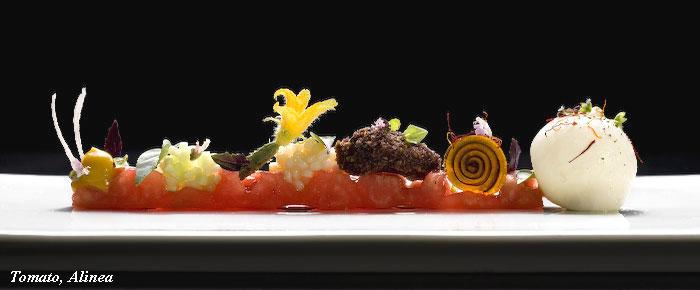
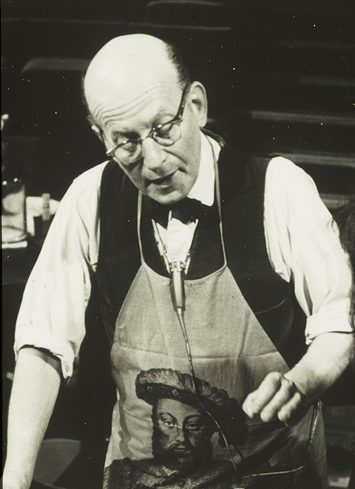 Though seemingly new, molecular gastronomy has been around since the time of Escoffier and the term was first introduced into the lexicon in 1988 by Hungarian physicist Nicholas Kurti (left)and French
Though seemingly new, molecular gastronomy has been around since the time of Escoffier and the term was first introduced into the lexicon in 1988 by Hungarian physicist Nicholas Kurti (left)and French 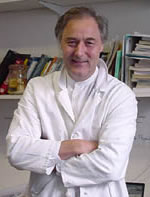 physical chemist Hervé This (below, pronounced "Tees"). It became the title for a set of workshops that they held in Erice, Italy that brought together scientists and professional cooks for discussions on the science behind traditional cooking preparations. "Molecular Gastronomy," first based on exploring the science behind traditional cooking methods,
physical chemist Hervé This (below, pronounced "Tees"). It became the title for a set of workshops that they held in Erice, Italy that brought together scientists and professional cooks for discussions on the science behind traditional cooking preparations. "Molecular Gastronomy," first based on exploring the science behind traditional cooking methods,
What I have noticed, is a marked loyalty to the pro or con when it comes to this issue. I myself, happen to like both, so for my tastes I feel I get the best of both worlds. Since the individual palate is as diverse as the person to whom it belongs, the opinions are just as varied. The other thing that 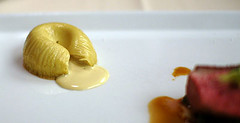 must be mentioned is that while we may discuss what it is in picture and word, the true experience is in the eating. Until you have had a creamy caramel sphere burst warm liquidy deliciousness inside your mouth, or Foie Gras Ganache (left), ooze onto your plate, you will never truly know the joys that can come from the science of food.
must be mentioned is that while we may discuss what it is in picture and word, the true experience is in the eating. Until you have had a creamy caramel sphere burst warm liquidy deliciousness inside your mouth, or Foie Gras Ganache (left), ooze onto your plate, you will never truly know the joys that can come from the science of food.
If you are a fan of this discipline, as we are, then you are familiar with those chefs, such as Ferran Adrià, Grant Achatz (pictured below), Wylie Dufresne, Jose Andres, Thomas Keller and Heston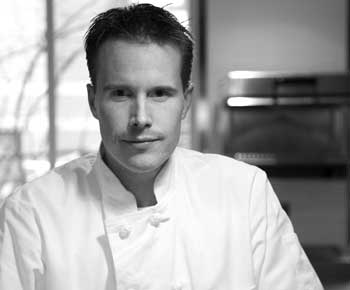 Blumenthal, as well as a handful of others that push the limits of creativity by breaking the boundaries between the lab and the table. If you are not familiar with it, you should be, if for no other reason than to have experienced the genre at least once.
Blumenthal, as well as a handful of others that push the limits of creativity by breaking the boundaries between the lab and the table. If you are not familiar with it, you should be, if for no other reason than to have experienced the genre at least once.
What I think you will be surprised about, as I was, is the fact that many of these same chefs are not big fans of the term molecular gastronomy. Now don't get me wrong, we all agree what they are doing pushes the boundaries of taste and dining into the highest levels, but they are concerned that what they do is misunderstood because of the term. You'll read some quotes from some of them here that may put things in perspective, especially if this is an art form that captures your imagination, as it does ours.
What is it exactly?
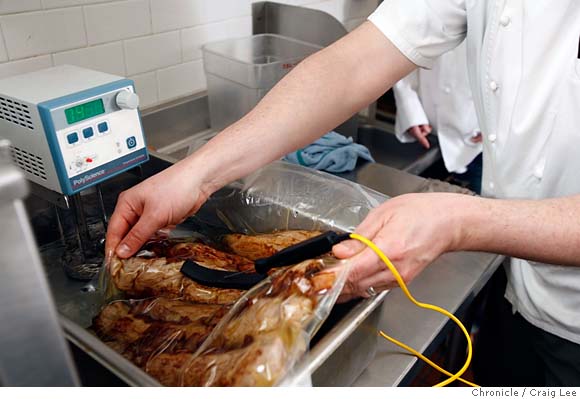 There are many branches of food science, all of which study different aspects of food such as safety, microbiology, preservation, chemistry, engineering, physics and the like. Until the advent of molecular gastronomy, there was no formal scientific discipline dedicated to studying the processes in regular cooking as done in the home or in a restaurant. The aforementioned (perhaps with the exception of food safety) have mostly been concerned with industrial food production and while the disciplines may overlap with each other to varying degrees, they are considered separate areas of investigation.
There are many branches of food science, all of which study different aspects of food such as safety, microbiology, preservation, chemistry, engineering, physics and the like. Until the advent of molecular gastronomy, there was no formal scientific discipline dedicated to studying the processes in regular cooking as done in the home or in a restaurant. The aforementioned (perhaps with the exception of food safety) have mostly been concerned with industrial food production and while the disciplines may overlap with each other to varying degrees, they are considered separate areas of investigation.
According to Wikipedia, the discipline covers some of these areas: How ingredients are changed by different cooking methods How all the senses play their own roles in our appreciation of food The mechanisms of aroma release and the perception of taste and flavor How and why we evolved our particular taste and flavor sense organs and our general food likes and dislikes. How cooking methods affect the eventual flavor and texture of food ingredients How new cooking methods might produce improved results of texture and flavor How our brains interpret the signals from all our senses to tell us the "flavor" of food How our enjoyment of food is affected by other influences, our environment, our mood, how it is presented, who prepares it, etc. |
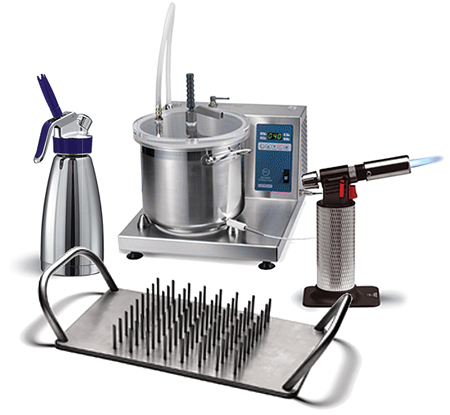 Though many disparate examples of the scientific investigation of cooking exist throughout history, the creation of the discipline of molecular gastronomy was intended to bring together the chemical and physical processes of cooking. It broke it into an organized discipline within food science, A. To address what the other disciplines within food science do not cover and, B. Cover it in a manner intended for scientists rather than cooks.
Though many disparate examples of the scientific investigation of cooking exist throughout history, the creation of the discipline of molecular gastronomy was intended to bring together the chemical and physical processes of cooking. It broke it into an organized discipline within food science, A. To address what the other disciplines within food science do not cover and, B. Cover it in a manner intended for scientists rather than cooks.
Here's a perfect example of new knowledge brought about by molecular gastronomy:
A soufflé is based on a viscous preparation, for example a Bechamel sauce made of butter, flour and milk, to which is added cheese, egg yolks and whisked egg whites. It used to be thought that soufflés 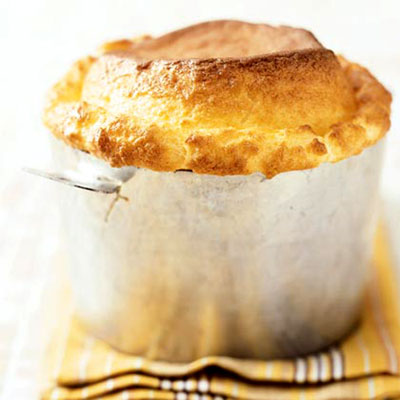 rose as the air bubbles in the egg whites grew bigger as they became warmer. However, Hervé This has measured the temperature and pressure inside a soufflé and calculated that the bubbles can swell by 20 per cent at the most, whereas soufflés can double in volume.
rose as the air bubbles in the egg whites grew bigger as they became warmer. However, Hervé This has measured the temperature and pressure inside a soufflé and calculated that the bubbles can swell by 20 per cent at the most, whereas soufflés can double in volume.
In fact, the soufflé rises as water from the milk and yolks evaporates, and rises to the top of the soufflé, pushing the layers of mixture upwards. This means that heating the container from the bottom produces the best results. He has also found that the stiffer the egg whites, the more the soufflé rises. The firmer egg whites have a greater volume to begin with, but the firmness of the foam also prevents the bubbles from passing quickly through the soufflé and escaping; slowly rising bubbles are better at pushing up the layers of mixture.
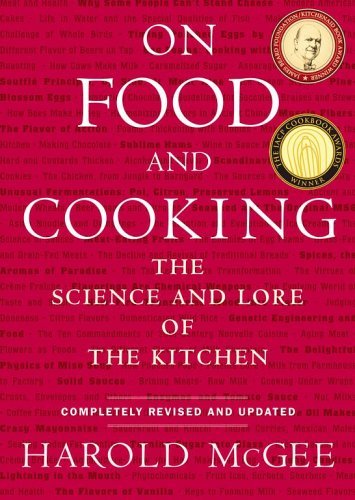 Up until this time, most chefs will harken back to what many have called the bible of true cookery for a professional and semi-professional chef, Harold McGee's book, "On Food and Cooking: The Science and Lore of the Kitchen," a publication that provided the chefs mentioned, as well as many other chefs, with the technical understanding they needed to help them create their dishes.
Up until this time, most chefs will harken back to what many have called the bible of true cookery for a professional and semi-professional chef, Harold McGee's book, "On Food and Cooking: The Science and Lore of the Kitchen," a publication that provided the chefs mentioned, as well as many other chefs, with the technical understanding they needed to help them create their dishes.
The irony is that some of the chefs most thought of when the term molecular gastronomy is used, are still not quite comfortable with the phrase. There seems to be plenty of opinions about the term and discipline. In layman's terms, I believe a quote from Chef Grant Achatz of Alinea in Chicago says it best. In a recent post on his blog, Back of the House on TheAtlantic.com, about the continuing debate over the term and discipline; "...this horse has been beaten down and down and down. Science is an integral part of cooking. What we (the so-called "molecular gastronomists") are doing is about far more than just science; it's about crafting an experience, about creativity, and about change."
Chef Heston Blumenthal of the UK's 3 star Michelin rated Fat Duck, in Bray, stated he thinks the term creates artificial barriers. 'Molecular makes it sound complicated,' he says. 'And gastronomy makes it sound elitist.' However, he accepts that, by pairing mustard ice creams with red-cabbage gazpacho, sprinkling cocoa powder over cauliflower risotto and making snail porridge, he has 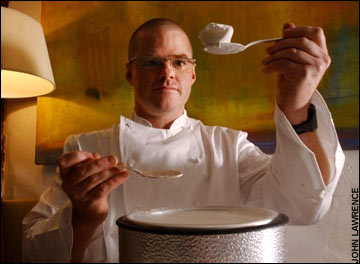 pushed back the boundaries on flavor combinations. 'It's the diners who have become most open. Six or seven years ago when I put a crab ice cream on my menu, it was regarded as the devil. Now if something like that is done for the first time, I don't think anybody bats an eyelid.'
pushed back the boundaries on flavor combinations. 'It's the diners who have become most open. Six or seven years ago when I put a crab ice cream on my menu, it was regarded as the devil. Now if something like that is done for the first time, I don't think anybody bats an eyelid.'
"In late 1999, one of the most widely reported of our discoveries was the combination of caviar and white chocolate," says Chef Blumenthal. "I demonstrated this combination to one of the world's leading flavorists (This), who was amazed at the marriage.... He went off and came back with a printout [of the chemical makeup] of cocoa and caviar, and sure enough, they both contained high levels of amines."
Hervé This's research helps the Fat Duck staff blend some unusual ingredients. Spice bread ice 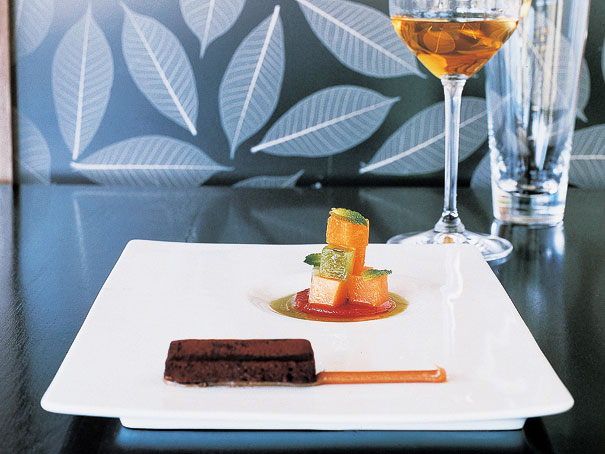 cream and crab syrup, smoked bacon and egg ice cream served with French toast and tomato jam, and oysters and passion-fruit jelly are a few examples. They may sound odd, but these are winning combinations.
cream and crab syrup, smoked bacon and egg ice cream served with French toast and tomato jam, and oysters and passion-fruit jelly are a few examples. They may sound odd, but these are winning combinations.
Hervé has recorded more than 10,000 examples of adages, all of which get written down in a notebook. He tries to test as many sayings as possible, and after many lab experiments and a number of failed dinner parties, he has managed to disprove or improve upon many maxims.
He regularly teams up with chefs to exchange information. Every month, he picks a theme based on his research and challenges his friend, three-star French chef Pierre Gagnaire, to invent a recipe from it. "We work very hard, and Hervé's research helps us to find new perspectives," says Gagnaire, who is known for his innovative cuisine and food combinations.
While it may not have a proper moniker according to these chefs, the presentations that it represents are very much in the forefront of moving food into areas never before explored. Creations such as Blood Orange Foam, or Chef Marcus Samuelsson's 'Foie Gras Ganache,' are true genius applications of time honored traditional ingredients and dishes, presented with new imagination and flair.

But, it’s also about what arrives at your table as well. What do diners see? How do they interact with the food? How is their experience changed by the surrealistic plating and surprising presentation, or ingredients that look like other food, or scented air released from air pillows while you dine?
To me, molecular gastronomy is more about the experimentation of flavor profiles and presentation, 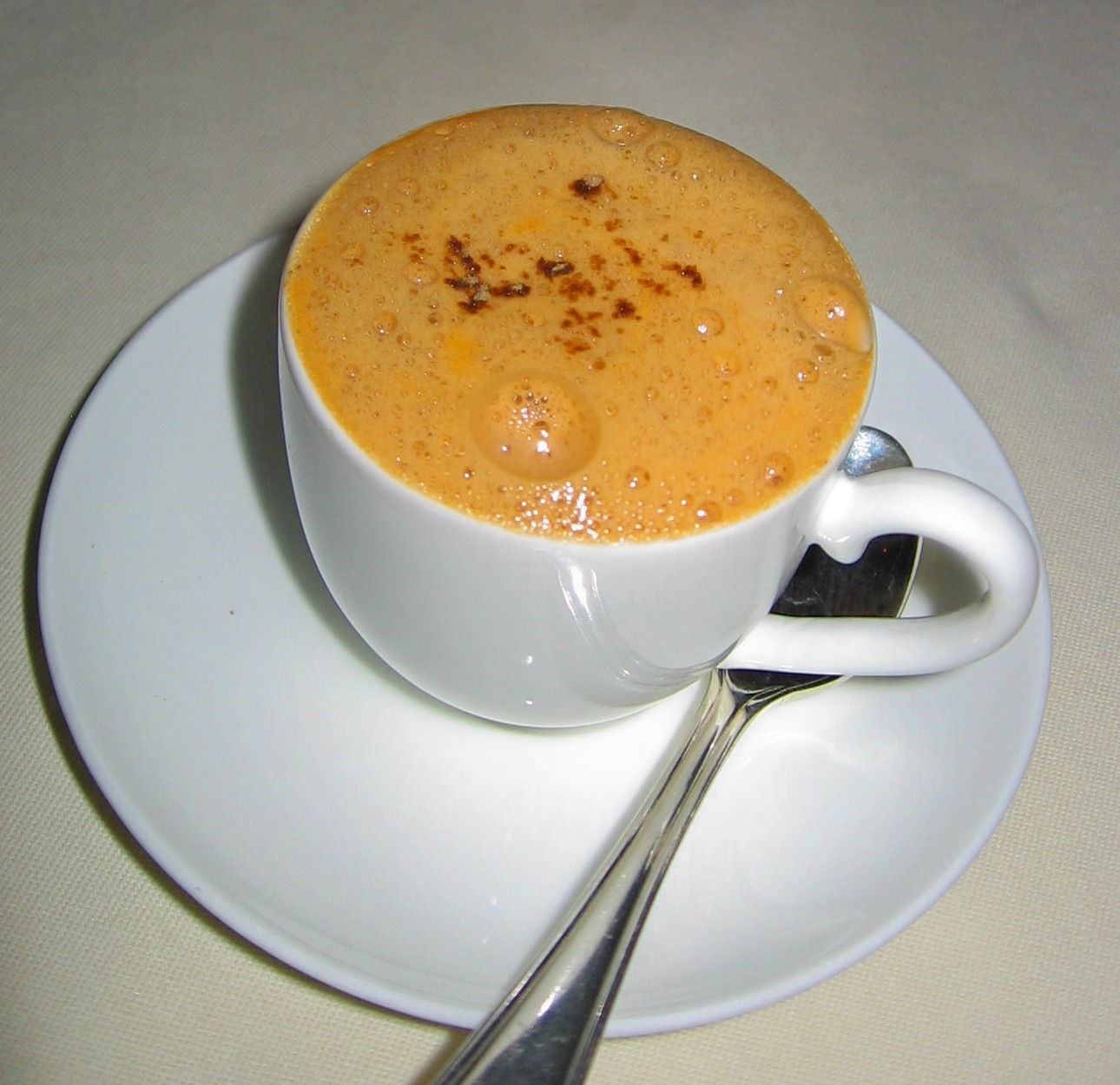 than it is about science. Yes, new techniques including the use of lecithins, the making of foams and the uses of nitrogens are all making the blending of ingredients and the focus on textures and mouth feel all factor into the discipline. Personally, I think that the major focus has always been interesting and never thought of combinations and flavor profiles using fresh and unique ingredients. This was evidenced to me recently in this month's Restaurant Profile, when I enjoyed a delicious Basil & Lime Sorbet or the delicious Lobster Bisque Cappuccino (pictured left) prepared for me by Guy Martin protégée, Phillipe Ruiz.
than it is about science. Yes, new techniques including the use of lecithins, the making of foams and the uses of nitrogens are all making the blending of ingredients and the focus on textures and mouth feel all factor into the discipline. Personally, I think that the major focus has always been interesting and never thought of combinations and flavor profiles using fresh and unique ingredients. This was evidenced to me recently in this month's Restaurant Profile, when I enjoyed a delicious Basil & Lime Sorbet or the delicious Lobster Bisque Cappuccino (pictured left) prepared for me by Guy Martin protégée, Phillipe Ruiz.
Examples of Molecular Gastronomy
 Flash-freezing
Flash-freezing
Related back to my first query about flash freezing to make ice cream, El Bulli was the first restaurant to experiment with quickly freezing the outside of various foods, sometimes leaving a liquid center, using a volatile set-up involving a bowl of liquid nitrogen dubbed the TeppanNitro. Later, Alinea’s Achatz began using an appliance called the Anti-Griddle, whose metal surface freezes rather than cooks.
 Spherification
Spherification
Also known as ravioli (not the kind you eat with marinara sauce), spheres are what you get when you mix liquid food with sodium alginate, then dunk it in a bath of calcium chloride. A sphere looks and feels like caviar, with a thin membrane that pops in your mouth, expunging a liquid center. Popular experiments from the chefs above have included ravioli made from purées of things like mangoes and peas. A perfect example of this is Chef Mikkelsen's recent foray with Tequila Caviar.
 Meat glue
Meat glue
One of the greatest hits of the movement has been Wylie Dufresne’s “shrimp noodles,” which, as the name states, are noodles made of shrimp meat. They were created using transglutaminase, or meat glue, as it’s known in wd-50’s kitchen, a substance that binds different proteins together and is more familiarly used in mass-produced foods like chicken nuggets.
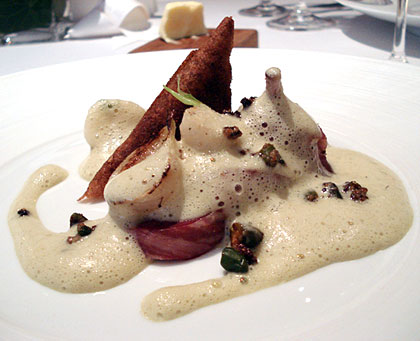 Foams
Foams
You probably know about foams, which are sauces that have been turned into froth using a whipped cream canister and sometimes lecithin as a stabilizer. They were invented at El Bulli, along with similar “airs” made with an immersion blender. I must admit this is one of my favorite applications of the discipline.
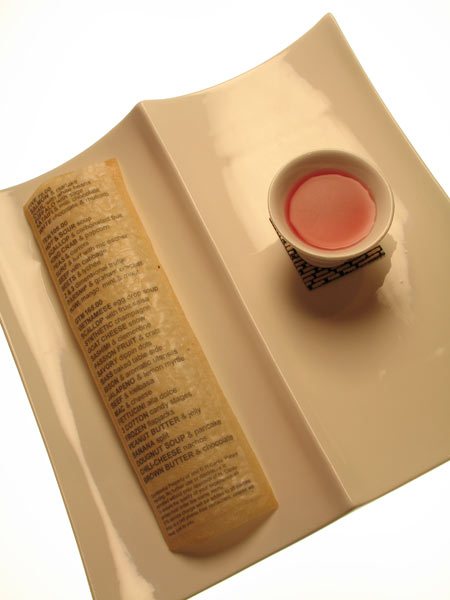
Edible menus
Probably the biggest wow factor innovation has been the edible menus by Homaro Cantu of Moto. Using an ink-jet printer adapted for inks made from fruit and vegetables, and paper made of soybean and potato starch, he has created menus that taste like everything from sushi to steak.
Bacon
 Alinea’s multi course tasting menu often includes a crispy piece of bacon decorated with butterscotch and dehydrated apple, served threaded on a horizontal wire. The famous dish exemplifies Alinea’s use of creative serveware, and molecular gastronomy’s enthusiasm for dehydrators and savory-sweet combinations in general. There has also been a huge movement recently to bacon and chocolate, and though I love both, I must admit, I am not a fan of this combination.
Alinea’s multi course tasting menu often includes a crispy piece of bacon decorated with butterscotch and dehydrated apple, served threaded on a horizontal wire. The famous dish exemplifies Alinea’s use of creative serveware, and molecular gastronomy’s enthusiasm for dehydrators and savory-sweet combinations in general. There has also been a huge movement recently to bacon and chocolate, and though I love both, I must admit, I am not a fan of this combination.
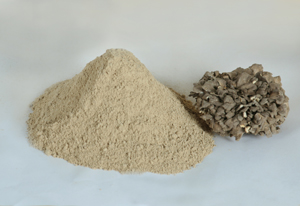
Dusts & Dehydration
The dehydration of certain well known ingredients into a dust which changes the way one might use these ingredients, an example would be Black Chanterell or Black Trumpet mushrooms. We have had this dust added to dishes as wide ranging as soups, steaks and foie gras.
Prologue
While Molecular Gastronomy may not be for you, we highly suggest that you experience this dining genre at least once. The creativity of chefs and restaurants embracing the nuances of breaking down food to the molecular level is moving food, dining and presentation to even higher levels than ever before, and frankly, we like where it is going and are excited to see who will push the boundaries of the culinary envelope even further. As the 'dining public' we are the beneficiaries of these talented chefs and the masterpieces they create on a plate.
Bon Apetit!


